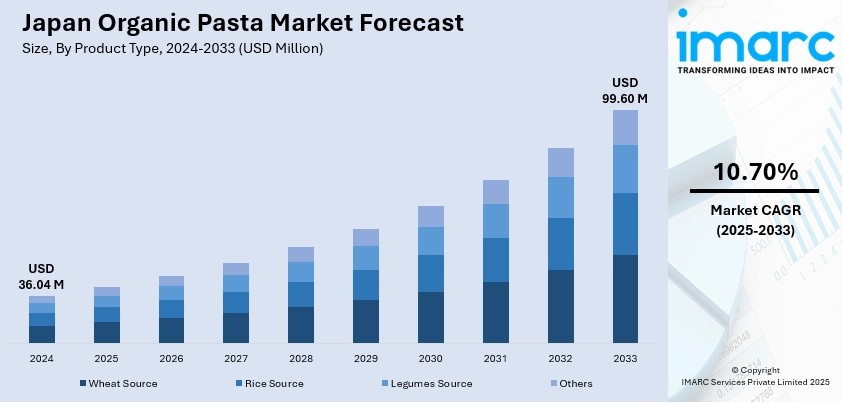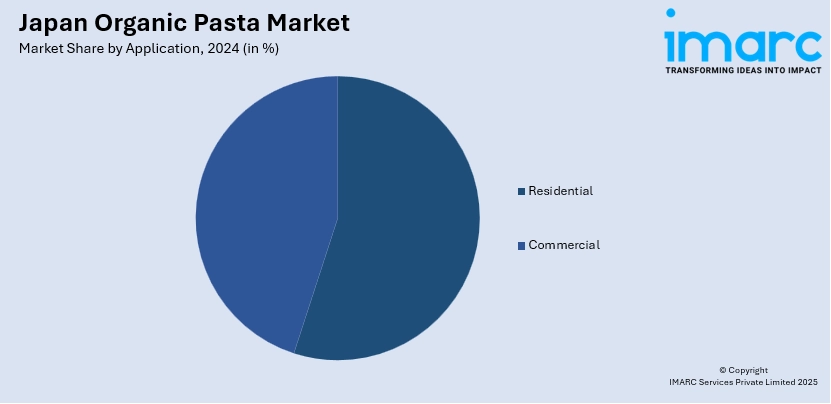
Japan Organic Pasta Market Size, Share, Trends and Forecast by Product Type, Application, Distribution Channel, and Region, 2025-2033
Japan Organic Pasta Market Overview:
The Japan organic pasta market size reached USD 36.04 Million in 2024. Looking forward, IMARC Group expects the market to reach USD 99.60 Million by 2033, exhibiting a growth rate (CAGR) of 10.70% during 2025-2033. The market is fueled by increased health consciousness, as customers look for natural, additive-free foods for improved nutrition and safety. Increased interest in plant-based and vegan diets also stimulates demand, as organic pasta from alternate grains fits in with these lifestyles. The growth of e-commerce and broader distribution through supermarkets and specialty outlets also enhances availability, facilitating easier customer purchases of organic pasta hence consolidating the Japan organic pasta market share.
|
Report Attribute
|
Key Statistics
|
|---|---|
|
Base Year
|
2024 |
|
Forecast Years
|
2025-2033
|
|
Historical Years
|
2019-2024
|
| Market Size in 2024 | USD 36.04 Million |
| Market Forecast in 2033 | USD 99.60 Million |
| Market Growth Rate 2025-2033 | 10.70% |
Japan Organic Pasta Market Trends:
Health and Wellness Focus
Health-conscious living is a priority for many Japanese consumers, driving the rising demand for organic pasta. There is growing caution around the use of synthetic chemicals and genetically modified ingredients in conventional food products. Organic pasta, which tends to be produced from wholesome, natural grains, is therefore perceived as healthier and safer. Individuals with food allergy or sensitivity also opt for organic products, particularly gluten-free products. This increasing consciousness about health inspires consumers to select organic pasta based on its perceived cleanliness and health advantages. Additionally, organic foods are easier to access via supermarkets, specialty stores, and internet retailers, allowing health-oriented consumers to make organic pasta part of their regular diets. This is part of a wider tendency in Japan toward clean eating and transparency in food.

To get more information on this market, Request Sample
Rise of Plant-Based and Vegan Diets
In Japan, the growing trend of plant-based and vegan diets is increasing demand for organic pasta, especially among healthy and environmentally conscious consumers. Consumers increasingly prefer pasta from alternative grains like chickpeas, lentils, and quinoa, which are protein-rich and more suited to vegetarian and vegan nutritional requirements. Concerns about environmental sustainability and animal welfare are also driving this trend, with consumers demanding ethical and sustainable food choices. Organic pasta naturally aligns with this lifestyle, providing clean-label, non-GMO versions of standard wheat-based products. Influencers on social media and wellness campaigners are increasing the popularity, featuring organic pasta in plant-based dishes and highlighting the benefits. With increasing awareness, organic pasta is becoming not only a health food staple but also a fashionable food option. This Japan organic pasta market trend presents a major growth opportunity for producers targeting Japan’s expanding base of mindful and plant-forward consumers.
Growth of E-commerce and Distribution Channels
The growth of e-commerce has contributed immensely to Japan's market for organic pasta by providing consumers with increased convenience, variety, and accessibility. Online channels enable consumers to simply navigate and buy organic goods at home, which is particularly attractive to people who are busy or health-oriented. This online transformation makes it easier for brands to connect with consumers, tailor marketing efforts, and build loyalty. Simultaneously, physical stores like supermarkets, health food markets, and organic specialty stores are growing their organic pasta offerings, appealing to consumers who enjoy in-store shopping. The combination of digital and physical retailing channels ensures that organic pasta can be accessed across different consumer preferences. This multi-channel strategy helps to address increasing consumer demand for organic, sustainable food products and facilitates entry for consumers to incorporate these products into their everyday diets thus aiding the Japan organic pasta market growth.
Japan Organic Pasta Market Segmentation:
IMARC Group provides an analysis of the key trends in each segment of the market, along with forecasts at the country and regional levels for 2025-2033. Our report has categorized the market based on product type, application, and distribution channel.
Product Type Insights:
- Wheat Source
- Rice Source
- Legumes Source
- Others
The report has provided a detailed breakup and analysis of the market based on the product type. This includes wheat source, rice source, legumes source, and others.
Application Insights:

- Residential
- Commercial
A detailed breakup and analysis of the market based on the application have also been provided in the report. This includes residential and commercial.
Distribution Channel Insights:
- Offline Stores
- Online Stores
The report has provided a detailed breakup and analysis of the market based on the distribution channel. This includes offline stores and online stores.
Regional Insights:
- Kanto Region
- Kansai/Kinki Region
- Central/ Chubu Region
- Kyushu-Okinawa Region
- Tohoku Region
- Chugoku Region
- Hokkaido Region
- Shikoku Region
The report has also provided a comprehensive analysis of all the major regional markets, which include Kanto Region, Kansai/Kinki Region, Central/ Chubu Region, Kyushu-Okinawa Region, Tohoku Region, Chugoku Region, Hokkaido Region, and Shikoku Region
Competitive Landscape:
The market research report has also provided a comprehensive analysis of the competitive landscape. Competitive analysis such as market structure, key player positioning, top winning strategies, competitive dashboard, and company evaluation quadrant has been covered in the report. Also, detailed profiles of all major companies have been provided.
Japan Organic Pasta Market News:
- In January 2025, Natural Grocers® launched six new organic wheat pastas and five organic pasta sauces under its house brand. Made from organic durum wheat semolina, the pastas are certified organic, vegan, non-GMO, and dairy-free. The sauces are certified organic, gluten-free, non-GMO, and four are Demeter Certified Biodynamic, supporting sustainable farming. This new line emphasizes taste, quality, and sustainability for health-conscious consumers.
- In December 2024, Realfoods by Organico launched a new range of seven organic pasta varieties, crafted using traditional slow proofing and drying methods in Bari, Puglia. Made from high-quality durum wheat and pure spring water, the pasta stands out for its artisanal production using old-school bronze plates. With spaghetti’s global popularity soaring, especially in markets like Japan and North America, Organico offers a premium, authentic option for pasta lovers to enjoy alongside their sauces.
Japan Organic Pasta Market Report Coverage:
| Report Features | Details |
|---|---|
| Base Year of the Analysis | 2024 |
| Historical Period | 2019-2024 |
| Forecast Period | 2025-2033 |
| Units | Million USD |
| Scope of the Report |
Exploration of Historical Trends and Market Outlook, Industry Catalysts and Challenges, Segment-Wise Historical and Future Market Assessment:
|
| Product Types Covered | Wheat Source, Rice Source, Legumes Source, Others |
| Applications Covered | Residential, Commercial |
| Distribution Channels Covered | Offline Stores, Online Stores |
| Regions Covered | Kanto Region, Kansai/Kinki Region, Central/ Chubu Region, Kyushu-Okinawa Region, Tohoku Region, Chugoku Region, Hokkaido Region, Shikoku Region |
| Customization Scope | 10% Free Customization |
| Post-Sale Analyst Support | 10-12 Weeks |
| Delivery Format | PDF and Excel through Email (We can also provide the editable version of the report in PPT/Word format on special request) |
Key Questions Answered in This Report:
- How has the Japan organic pasta market performed so far and how will it perform in the coming years?
- What is the breakup of the Japan organic pasta market on the basis of product type?
- What is the breakup of the Japan organic pasta market on the basis of application?
- What is the breakup of the Japan organic pasta market on the basis of distribution channel?
- What is the breakup of the Japan organic pasta market on the basis of region?
- What are the various stages in the value chain of the Japan organic pasta market?
- What are the key driving factors and challenges in the Japan organic pasta market?
- What is the structure of the Japan organic pasta market and who are the key players?
- What is the degree of competition in the Japan organic pasta market?
Key Benefits for Stakeholders:
- IMARC’s industry report offers a comprehensive quantitative analysis of various market segments, historical and current market trends, market forecasts, and dynamics of the Japan organic pasta market from 2019-2033.
- The research report provides the latest information on the market drivers, challenges, and opportunities in the Japan organic pasta market.
- Porter's five forces analysis assist stakeholders in assessing the impact of new entrants, competitive rivalry, supplier power, buyer power, and the threat of substitution. It helps stakeholders to analyze the level of competition within the Japan organic pasta industry and its attractiveness.
- Competitive landscape allows stakeholders to understand their competitive environment and provides an insight into the current positions of key players in the market.
Need more help?
- Speak to our experienced analysts for insights on the current market scenarios.
- Include additional segments and countries to customize the report as per your requirement.
- Gain an unparalleled competitive advantage in your domain by understanding how to utilize the report and positively impacting your operations and revenue.
- For further assistance, please connect with our analysts.
 Request Customization
Request Customization
 Speak to an Analyst
Speak to an Analyst
 Request Brochure
Request Brochure
 Inquire Before Buying
Inquire Before Buying




.webp)




.webp)












